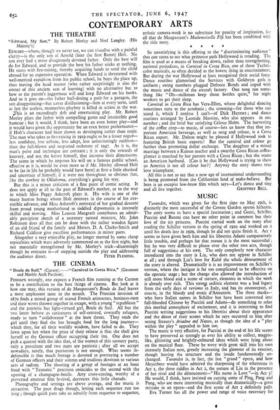THE CINEMA
PERHAPS wrongly, one expects a French film running at the Curzon to be a contribution to the best things of cinema. But look at it how one may, this version of de Maupassanes Boule de Suif leaves a most unpleasant taste in the mouth. The Prussian invasion of 1870 finds a mixed group of scared French aristocrats, business-men and their wives thrown together in escape, with a young " republican " and the patriotic but light-virtued girl, Boule de Suif. All but the two latter behave as caricatures of self-centred, cowardly refugees, ready to turn " coilaborator " at the least threat. They snub the girl until they find she has brought food for the long journey— which they, for all their worldly wisdom, have failed to do. They fawn upon her when the price of their release is that she shall give herself to the German officer occupying their inn. One does not pick a quarrel with the idea that, of the women of this savoury party, only a prostitute and two nuns are patriotic ; after all we accept nowadays, surely, that patriotism is not enough. What seems in- defensible is that much footage is devoted to portraying a number of German officers and their solemn and studious devotion to various acts of sadism. The shooting of a group of hostages at an hour fixed with " TeutoniC " precision coincides to the second with the opening of a champagne-bottle. Arty cross-cutting, worthy of a
perverted amateur film festival, decorates this little charade. • Photography and settings are above average, and the music is attractive. The pace drags though, letting each sequence run too long ; though quick pans take us adroitly from sequence to sequence,
artistic camera-work is no substitute for paucity of inspiration, for all that de Maupassant's Mademoiselle Fifi has been combined with the title story.
* * * *
So unsatisfying is this offering to the "discriminating audience" that one turns to see what primrose path Hollywood is treading. The film is used as a means of breaking down, rather than strengthening, national prejudices, in Carnival in Costa Rica, one of those Techni- color musicals, so often derided as the lowest thing in entertainment. But during the war Hollywood at least recognised their social force. Dance routines glamorised the Services with Goldwyn girls in uniform; swing numbers plugged Defence Bonds and coped with the music and dance of the aircraft factory. One song ran some- thing like "Oh—milkman keep those bottles quiet," for -night workers to get their sleep.
Carnival in Costa Rica has Vera-Ellen, whose delightful dancing sometimes runs to the acrobatic ; the crooning—for those who can stand it, which I confess I can't—of Dick Haymes ; and dance routines arranged by Leonide Massine, who also appears in one number ; and the brief but satisfying Celeste Holm. The harvesting of the coffee crop—to music, of course—lets us know that that im- portant American beverage, as well as song and colour, is a Costa Rican export. Mr. Dalton might be pleased if Hollywood took to featuring British basic exports! But the carnival and colour go further than promoting dollar exchange. The daughter of a mixed marriage between a Kansas teacher and a swarthy Costa Rican coffee- planter is matched by her parents with a Costa Rican ; but she wants an American husband. (Can it be that Hollywood is trying to show us America is not all colour bar?) Anyway the story shows true love triumphant.
All this is not to say that a new age of international understanding is being promoted from the Californian land of make-believe. But here is an escapist low-brow film which says—Let's dance and sing


































 Previous page
Previous page